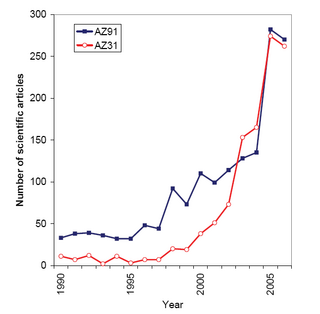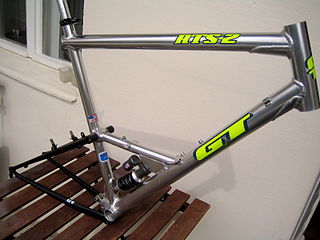Related Research Articles

Magnesium alloys are mixtures of magnesium with other metals, often aluminium, zinc, manganese, silicon, copper, rare earths and zirconium. Magnesium alloys have a hexagonal lattice structure, which affects the fundamental properties of these alloys. Plastic deformation of the hexagonal lattice is more complicated than in cubic latticed metals like aluminium, copper and steel; therefore, magnesium alloys are typically used as cast alloys, but research of wrought alloys has been more extensive since 2003. Cast magnesium alloys are used for many components of modern automobiles and have been used in some high-performance vehicles; die-cast magnesium is also used for camera bodies and components in lenses.

An aluminium alloy (UK/IUPAC) or aluminum alloy is an alloy in which aluminium (Al) is the predominant metal. The typical alloying elements are copper, magnesium, manganese, silicon, tin, nickel and zinc. There are two principal classifications, namely casting alloys and wrought alloys, both of which are further subdivided into the categories heat-treatable and non-heat-treatable. About 85% of aluminium is used for wrought products, for example rolled plate, foils and extrusions. Cast aluminium alloys yield cost-effective products due to the low melting point, although they generally have lower tensile strengths than wrought alloys. The most important cast aluminium alloy system is Al–Si, where the high levels of silicon (4–13%) contribute to give good casting characteristics. Aluminium alloys are widely used in engineering structures and components where light weight or corrosion resistance is required.
6061 aluminium alloy is a precipitation-hardened aluminium alloy, containing magnesium and silicon as its major alloying elements. Originally called "Alloy 61S", it was developed in 1935. It has good mechanical properties, exhibits good weldability, and is very commonly extruded. It is one of the most common alloys of aluminium for general-purpose use.
7075 aluminium alloy (AA7075) is an aluminium alloy with zinc as the primary alloying element. It has excellent mechanical properties and exhibits good ductility, high strength, toughness, and good resistance to fatigue. It is more susceptible to embrittlement than many other aluminium alloys because of microsegregation, but has significantly better corrosion resistance than the alloys from the 2000 series. It is one of the most commonly used aluminium alloys for highly stressed structural applications and has been extensively used in aircraft structural parts.
2024 aluminium alloy is an aluminium alloy, with copper as the primary alloying element. It is used in applications requiring high strength-to-weight ratio, as well as good fatigue resistance. It is weldable only through friction welding, and has average machinability. Due to poor corrosion resistance, it is often clad with aluminium or Al-1Zn for protection, although this may reduce the fatigue strength. In older systems of terminology, 2XXX series alloys were known as duralumin, and this alloy was named 24ST.
5086 aluminium alloy is an aluminium–magnesium alloy, primarily alloyed with magnesium. It is not strengthened by heat treatment, instead becoming stronger due to strain hardening, or cold mechanical working of the material.
AA 6063 is an aluminium alloy, with magnesium and silicon as the alloying elements. The standard controlling its composition is maintained by The Aluminum Association. It has generally good mechanical properties and is heat treatable and weldable. It is similar to the British aluminium alloy HE9.
5083 aluminium alloy is an aluminium–magnesium alloy with magnesium and traces of manganese and chromium. It is highly resistant to attack by seawater and industrial chemicals.
Beryllium-aluminum alloy an alloy that consists of 62% beryllium and 38% aluminum, by weight, corresponding approximately to an empirical formula of Al2Be. It was first developed in the 1960s by the Lockheed Missiles and Space Company, who called it Lockalloy, and used as a structural metal in the aerospace industry because of its high specific strength and stiffness. The material was used in the Lockheed YF12 and LGM-30 Minuteman missile systems. In the 1970s production difficulties limited the material to a few specialized uses and by the mid 1970s Lockalloy was no longer commercially available.
5059 aluminium alloy is an aluminium–magnesium alloy, primarily alloyed with magnesium. It is not strengthened by heat treatment, instead becoming stronger due to strain hardening, or cold mechanical working of the material.
7068 aluminium alloy is one of the strongest commercially available aluminium alloys, with a tensile strength comparable to that of some steels. This material, also known as an aircraft alloy, is heat treatable.
6005A aluminium alloy is an alloy in the wrought aluminium-magnesium-silicon family. It is closely related, but not identical, to 6005 aluminium alloy. Between those two alloys, 6005A is more heavily alloyed, but the difference does not make a marked impact on material properties. It can be formed by extrusion, forging or rolling, but as a wrought alloy it is not used in casting. It cannot be work hardened, but is commonly heat treated to produce tempers with a higher strength at the expense of ductility.
6060 aluminium alloy is an alloy in the wrought aluminium-magnesium-silicon family. It is much more closely related to the alloy 6063 than to 6061. The main difference between 6060 and 6063 is that 6063 has a slightly higher magnesium content. It can be formed by extrusion, forging or rolling, but as a wrought alloy it is not used in casting. It cannot be work hardened, but is commonly heat treated to produce tempers with a higher strength but lower ductility.
6105 aluminium alloy is an alloy in the wrought aluminium-magnesium-silicon family. It is one of the least common of the alloys in this series. While most wrought aluminium alloys are covered by multiple standards, 6105 is only dealt with in ASTM B221: Standard Specification for Aluminum and Aluminum-Alloy Extruded Bars, Rods, Wire, Profiles, and Tubes. It is formed by extrusion, and supplied in heat treated form. It can alternately referred to by the UNS designation A96105.
6162 aluminium alloy is an alloy in the wrought aluminium-magnesium-silicon family. It is related to 6262 aluminium alloy in that Aluminum Association designations that only differ in the second digit are variations on the same alloy. It is similar to 6105 aluminium alloy, both in alloy composition and the fact that it is only really used in extrusions. However, as a wrought alloy, it can also be formed by rolling, forging, and similar processes, should the need arise. It is supplied in heat treated form. It can be referred to by the UNS designation A96162, and is covered by the standard ASTM B221: Standard Specification for Aluminum and Aluminum-Alloy Extruded Bars, Rods, Wire, Profiles, and Tubes.
The 6463 aluminium alloy is an aluminium alloy in the wrought aluminium-magnesium-silicon family. It is related to 6063 aluminium alloy, but unlike 6063 it is generally not formed using any processes other than extrusion. It is commonly heat treated to produce tempers with a higher strength but lower ductility. Like 6063, it is often used in architectural applications.
7034 aluminium alloy is a wrought type. It having a very high ultimate tensile strength of 750 MPa.
7055 alloy is heat treatable wrought aluminum alloy. It has high ultimate tensile strength value of 593 MPa.
7178 aluminum alloy is wrought alloy. It has high zinc content. After annealing, aluminum alloy 7178 has high machinability. Resistance welding can be used.
Aluminium–copper alloys (AlCu) are aluminium alloys that consist largely of aluminium (Al) and traces of copper (Cu) as the main alloying elements. Important grades also contain additives of magnesium, iron, nickel and silicon, often manganese is also included to increase strength. The main area of application is aircraft construction. The alloys have medium to high strength and can be age hardened. They are both wrought alloy. Also available as cast alloy. Their susceptibility to corrosion and their poor weldability are disadvantageous.
References
- 1 2 3 4 5 6 "7005 aluminum alloy properties". 31 August 2012.
- ↑ "Bicycle aluminum alloy". 14 August 2018.
- ↑ "matweb Aluminium 7005".
- ↑ Davis, Joseph R. (1993). Aluminum and Aluminum Alloys. ASM International. ISBN 9780871704962.
- ↑ "Make it From". Make it From. Archived from the original on 2015-11-09.
- ↑ "MatWeb - the Online Materials Information Resource". Archived from the original on 2014-04-27. Retrieved 2012-08-26.